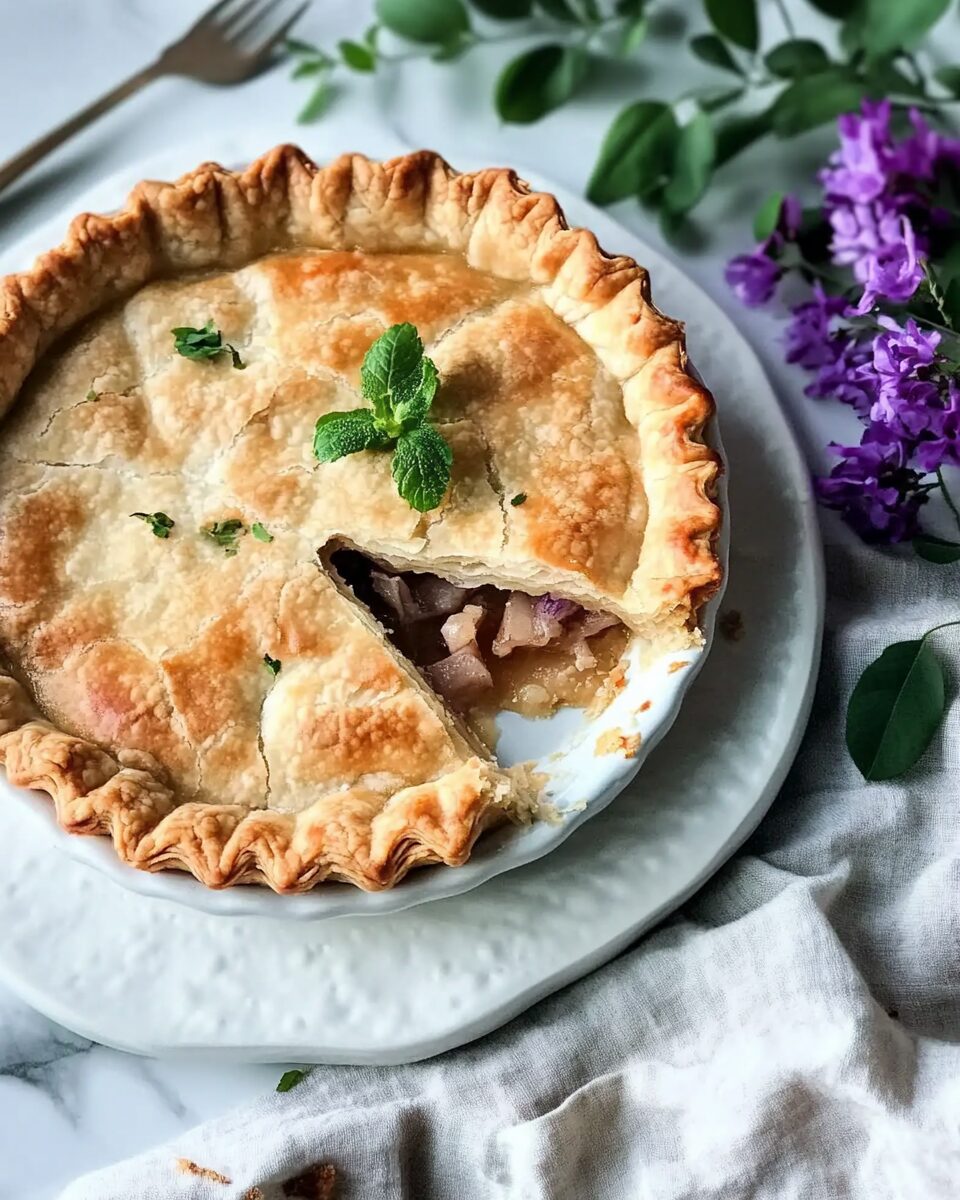Hot Water Crust Pastry is a traditional British pastry known for its sturdy, crisp texture and its ability to hold up against rich, meaty fillings. This crust is unique because it’s made with hot fat and boiling water, which allows it to be easily molded into a pie case while still warm. Unlike delicate shortcrust pastry, this dough remains robust and flaky even after baking, making it ideal for savory meat pies, pork pies, or any hearty dish requiring a firm crust.
This pastry is perfect for meal prep, as it can be made in advance and filled with your choice of ingredients. The rich, golden crust enhances both flavor and texture, while its ease of preparation makes it a go-to for home bakers and professional chefs alike. Whether you’re making a traditional British pork pie, a chicken and mushroom pie, or a classic steak and ale pie, this hot water crust will ensure a perfectly structured and mouthwatering result every time.
Full Recipe:
Ingredients:
- 3 cups (360g) all-purpose flour
- 1 teaspoon salt
- 1/2 cup (115g) unsalted butter
- 1/2 cup (115g) lard
- 3/4 cup (180ml) water
- 1 egg (for glazing)
Directions:
- Preheat the oven to 350°F (175°C) if baking immediately.
- In a large mixing bowl, combine the flour and salt.
- In a saucepan, melt the butter and lard over medium heat, then add water and bring to a near boil.
- Pour the hot liquid into the flour mixture, stirring quickly with a wooden spoon until a dough forms.
- Transfer the dough to a lightly floured surface and knead gently until smooth.
- Roll out the dough while still warm and shape it as desired for meat pies, pork pies, or hand pies.
- Brush the crust with beaten egg for a golden finish.
- Bake in a preheated oven for 45-50 minutes or until golden brown and crisp.
Prep Time: 10 minutes | Cooking Time: 50 minutes | Total Time: 1 hour
Kcal: 270 kcal per serving | Servings: 6 servings
Hot Water Crust Pastry: A Sturdy and Traditional British Pie Crust
Hot Water Crust Pastry is a unique and historical dough that has been used for centuries in British cuisine. Unlike traditional shortcrust or puff pastry, hot water crust is made by combining hot liquid fat with flour, which gives it a strong yet flaky texture. This method allows bakers to mold the dough into free-standing pie cases, making it perfect for savory meat pies, pork pies, and raised pies.
Unlike delicate pastry types that require careful handling and chilling, hot water crust is much more forgiving and easy to shape. It bakes into a crispy, golden-brown shell that remains sturdy enough to hold up against rich and juicy fillings. Whether you’re making a classic British Melton Mowbray pork pie, a hearty steak and ale pie, or a festive game pie, this crust is the foundation for some of the most iconic British bakes.
The History of Hot Water Crust Pastry
This pastry has deep roots in medieval England, where it was originally used to encase meats before baking. At that time, pies were often made with inedible crusts, serving more as a protective container than a flavorful component of the dish. However, as baking techniques evolved, hot water crust pastry became thinner, crisper, and deliciously golden, turning it into an essential part of the pie itself.
One of the most famous applications of hot water crust pastry is the Melton Mowbray Pork Pie, which has been a British delicacy since the 18th century. These pies are known for their hand-molded, free-standing shape and rich pork filling, often sealed with a layer of savory, flavorful aspic.
Today, hot water crust is still widely used across the UK and Europe, valued for its robustness and ability to hold moist, slow-cooked fillings without becoming soggy.
What Makes Hot Water Crust Pastry Different?
Hot water crust differs from other pastry types in several key ways:
-
It Uses Hot Fat Instead of Cold Butter
Unlike flaky pie crusts that require cold butter to create layers, hot water crust is made by melting lard (or butter) in boiling water, then mixing it into flour. This technique results in a pliable, moldable dough that firms up as it cools. -
It’s Sturdy and Can Stand on Its Own
Because of its firm yet tender texture, this crust is often used to make raised pies that don’t require a pie tin. The dough can be hand-shaped, pressed into molds, or wrapped around fillings, creating a rustic and hearty structure. -
It’s Perfect for Moist and Meaty Fillings
Since this crust is designed to be strong and crisp, it doesn’t get soggy even when paired with juicy, slow-cooked meat fillings. -
It Bakes to a Beautiful Golden-Brown
Thanks to the high fat content, hot water crust develops a rich, golden exterior when brushed with an egg wash before baking.
Why This Recipe is the Best Choice
- Foolproof and Easy to Work With – Unlike delicate pastry doughs that break easily, hot water crust remains pliable and is easy to roll and mold.
- Great for Meal Prep – You can make the dough ahead of time, store it in the fridge, and shape it when ready.
- Versatile for Savory Baking – Ideal for pork pies, chicken and mushroom pies, steak and ale pies, or vegetarian alternatives like cheese and onion pies.
- Long-Lasting and Durable – Baked pies with hot water crust can last for days without becoming soft or soggy, making them perfect for picnics and travel.
Tips for the Perfect Hot Water Crust Pastry
- Use Lard for Authenticity – While butter can be used, traditional hot water crust relies on lard for its firm, crisp texture.
- Work with the Dough While Warm – Hot water crust firms up as it cools, so it’s best to shape your pie quickly after mixing.
- Egg Wash for a Golden Finish – Brushing the crust with beaten egg before baking gives it a shiny, golden-brown look.
- Let It Rest Before Slicing – Allowing the pie to cool for at least 30 minutes after baking ensures that the filling sets properly.
Best Ways to Use Hot Water Crust Pastry
This dough is incredibly versatile, making it ideal for:
- Traditional British Pork Pies – The most famous use of hot water crust, typically filled with seasoned pork and gelatinous stock.
- Steak and Ale Pies – A rich, flavorful option featuring slow-cooked beef and stout-infused gravy.
- Chicken and Mushroom Pies – A creamy and comforting option with savory herbs and tender chicken.
- Cheese and Onion Pies – A vegetarian-friendly alternative, filled with sharp cheddar, caramelized onions, and potatoes.
- Raised Game Pies – Perfect for festive occasions, these pies feature a mix of venison, rabbit, and other meats.
How to Store and Freeze Hot Water Crust Pastry
- Refrigeration: Store the unbaked dough in an airtight container for up to 3 days.
- Freezing: You can freeze the dough for up to 2 months. Just thaw it overnight in the refrigerator before using.
- Pre-Baked Storage: Baked pies can be stored in the fridge for up to 5 days and reheated in the oven at 300°F (150°C) for 15 minutes.
How to Make the Perfect Hot Water Crust Pastry
Step 1: Melt the Fat
The defining feature of this pastry is the way the fat is incorporated. Unlike flaky pie doughs that use cold butter, hot water crust requires heating lard (or butter) with boiling water before mixing it into the flour. This step helps create a dough that is easy to roll, shape, and mold.
Step 2: Mix and Knead the Dough
Once the hot fat and water are added to the flour and salt, the mixture is stirred until combined and kneaded until smooth. It should be warm and pliable but not sticky.
Step 3: Work While Warm
Hot water crust firms up as it cools, so it’s best to roll and shape the dough immediately after mixing. If left too long, it will become too stiff to work with.
Step 4: Mold and Fill
This pastry can be shaped by hand, pressed into pie molds, or wrapped around fillings for traditional raised pies. The strong structure allows it to hold its shape during baking.
Step 5: Brush with Egg Wash
For a golden-brown, crispy crust, brush the pastry with a beaten egg before baking. This adds color and helps seal the surface.
Step 6: Bake to Perfection
Hot water crust bakes at 350°F (175°C) for 45-50 minutes, or until deep golden and firm to the touch.
Best Uses for Hot Water Crust Pastry
- Pork Pies – Traditional British pork pies are made by hand-shaping the crust and filling it with seasoned ground pork.
- Game Pies – Often filled with venison, rabbit, or duck, these pies are perfect for special occasions.
- Steak and Ale Pies – A classic combination of slow-cooked beef and dark ale in a rich gravy.
- Chicken and Mushroom Pies – A comforting filling with creamy mushrooms and tender chicken.
- Cheese and Onion Pies – A vegetarian option with cheddar cheese, caramelized onions, and potatoes.
Troubleshooting Hot Water Crust Pastry
- Pastry Too Hard? – This can happen if the dough is overworked or not enough fat is used. Ensure that the fat is fully melted before mixing.
- Pastry Cracking? – Work with the dough while it is still warm, as it firms up quickly.
- Crust Too Soft? – Ensure the oven is fully preheated and bake the pie long enough for a crisp finish.
- Pastry Too Greasy? – Reduce the amount of lard slightly or allow the pastry to rest before baking.
Conclusion
Hot Water Crust Pastry is a classic British dough that every home cook should master. With its crisp texture, golden color, and ability to hold rich fillings, it’s a staple in traditional meat pies and raised pastries. Whether you’re making a classic pork pie, a steak and ale masterpiece, or even a vegetarian cheese and onion bake, this pastry will deliver outstanding flavor and texture every time.
Give this recipe a try and enjoy the heartiness, history, and tradition of British baking!






